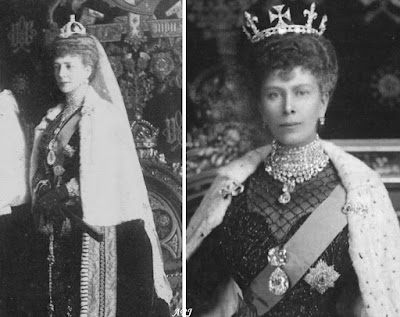 |
| The Cullinan I Diamond on its own (left) and mounted in the Sceptre (right) |
The Government of Transvaal presented the diamond, along with Cullinan II (the Lesser Star of Africa) to King Edward VII on November 9, 1907 at Sandringham House. The King then announced to the Secretary of State for the Colonies, Lord Elgin, that he accepted the magnificent gift ‘for myself and successors’, thus effectively designating the stones as Crown Jewellery.
 |
| Queen Alexandra (left) and Queen Mary (right) wearing Cullinans I and II in a brooch setting |
After Edward VII’s death in 1910, the new King commissioned Garrard to incorporate the diamond into the existing Crown Regalia, thus fulfilling King Edward’s wish to include the stone in the Crown Jewels. To that end, the Sovereign’s Sceptre with Cross was modified to hold Cullinan I. The structure which holds the diamond is hinged so that the stone may be removed and worn separately.
Queen Mary has worn Cullinan I and Cullinan II separately several times. She also wore them in a brooch setting, with Cullinan III and IV (also in a brooch setting) handing from her diamond necklaces. The stone has very rarely been removed from its sceptre setting since 1930s.
 |
| The Sovereign's Sceptre with Cross |
To read more about the fascinating story of the uncut diamond, have a look at this article: Day in History - The world’s largest diamond ever, the Cullinan, is found.
Sources and photo credits: Royal Collection, “Diamond: A Journey to the Heart of an Obsession” by Matthew Hart, “The Queen’s Diamonds” by Hugh Roberts, "The Queen's Jewels" by Leslie Field

No comments:
Post a Comment